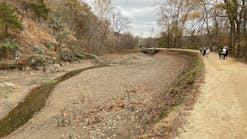The U.S. EPA has completed the Illinois River Watershed Basin and Lake Tenkiller models and released them to the partnering agencies for use. The EPA partnered with Arkansas, Oklahoma and the Cherokee Nation to develop science-based water quality models. Partner agencies can now use the models to evaluate options as they continue to reduce phosphorus loadings from sources in northeast Oklahoma and northwest Arkansas.
The models simulate conditions within the Illinois River Watershed and in Lake Tenkiller. These models can be used to evaluate options and their ability to improve water quality. EPA completed calibration as well as a sensitivity and uncertainty evaluation for the watershed and lake models.
Both states have committed to sharing the models and information with stakeholders within the impacted areas and will encourage feedback and involvement within their jurisdictions. Partner agencies will continue to collaborate during the coming months.
Nutrient pollution is one of America’s most widespread, costly and challenging environmental problems, and is caused by excess nitrogen and phosphorus in the air and water. Phosphorus levels in the Illinois River can be caused by various types of city and industrial discharges as well as nonpoint source runoff. The downstream impacts to Lake Tenkiller may include ‘algal blooms’ and low dissolved oxygen concentrations in the lake.






